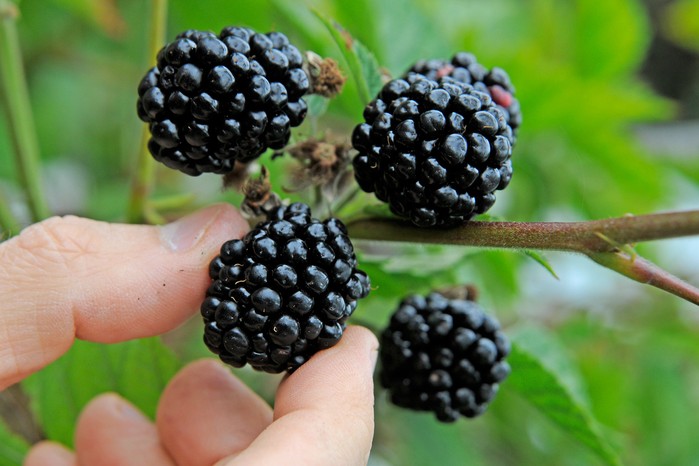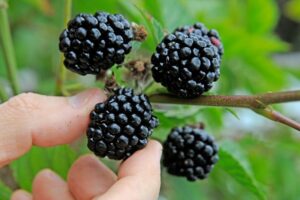If you live in a rural hamlet or an urban hub, blackberries can bring luscious flavour, colour, and character to your outdoor space. More than just a bramble that grows in hedgerows, blackberries stand among the most rewarding garden crops for anyone seeking to expand their culinary repertoire. From home baking enthusiasts eager to craft the perfect crumble to those simply wanting to snack on fresh berries, growing blackberries offers the possibility of endless gastronomic delights. Cultivating these hardy berries is a process that intertwines practicality, sustainability, and a true celebration of the British summertime harvest.
Table of Contents
ToggleThe Timeless Appeal of Blackberries
Blackberries, with their deep purple hues and delicate balance of sweet and tart flavours, have captivated palates for centuries. In Britain, blackberries are often associated with late summer and early autumn, when the brambles in hedgerows become laden with fruit. For those with a keen interest in gardening, cultivating blackberries in a dedicated patch or orchard area can transform a humble slice of land into a realm of culinary possibility.
Blackberries not only taste delightful but are also a nutritious addition to any diet. They contain vitamins C and K, manganese, and an array of antioxidants. Their bright, rich flavours can enhance traditional British desserts such as pies, crumbles, and puddings. They can also be used creatively in savoury dishes, paired with meats or cheeses, or turned into refreshing beverages. Thanks to their adaptability, blackberries can be grown across a range of soil types and climates, making them particularly popular amongst both novice and seasoned gardeners alike.
One nursery specialist at ChrisBowers notes that blackberries for sale remain an excellent choice for home gardeners who value productivity and ease of maintenance. Their resilience, coupled with their capacity to produce abundant harvests, makes them a reliable favourite. While blackberries have long been prized for their use in jams and desserts, the modern gardener increasingly uses them in innovative ways, from pairing them with herbs to creating spiced sauces for roast meats. According to the specialist, “Choosing the right blackberry variety can significantly impact not only the flavour of your harvest but also how you care for your plants. Prickle-free cultivars, for instance, simplify maintenance and picking, making blackberries a practical and rewarding option for all garden types.”
Growing Blackberries in Your Garden
Starting your own blackberry patch might feel like a daunting prospect if you have never grown berries before. Fortunately, blackberries are one of the most approachable species to cultivate, as they are known for their robust growth patterns and ability to thrive in diverse conditions. Before planting, it is important to consider your garden’s environment, your desired yield, and how you plan to use your blackberries in the kitchen.
In Britain, blackberries prefer a spot that receives full sun for most of the day, although they can tolerate partial shade. Soil quality is another key consideration. Like most fruiting plants, blackberries do best in fertile, well-draining soil. Slightly acidic conditions, typical of many British soils, are generally suitable, though they also cope well with more neutral pH levels. Good drainage is essential, as blackberries do not appreciate having their roots waterlogged. If your soil is heavy or clay-based, improving its structure by adding compost or well-rotted manure can help ensure the plants’ roots remain healthy.
Planting at the correct time can improve the chances of success. Blackberries are generally planted during their dormant season, which is typically late autumn to early spring. This timing gives them an opportunity to establish roots before the demands of active growth in warmer months set in. However, it is possible to plant container-grown blackberries at almost any time of year, as long as the ground is not frozen or waterlogged.
When deciding how much space to give your blackberry patch, remember that these plants can spread significantly. Traditional blackberry canes can grow several metres in length, so providing adequate support, such as a trellis or wires along a fence, helps keep your blackberry garden organised and easy to maintain. If you select a thorny variety, consider placing the canes away from paths or children’s play areas to avoid unwanted pricks. On the other hand, modern thornless varieties can offer a more family-friendly approach without sacrificing yield.
Once your canes are in the ground, proper feeding and watering are essential for a bountiful harvest. As with many fruit crops, blackberries appreciate a good, organic mulch around the base to help suppress weeds and retain moisture. While they are relatively drought-tolerant, providing consistent watering, especially during fruiting, promotes plump, juicy berries. Pay attention to weed control since blackberries do not enjoy competition, and consider using natural methods of weed suppression, like straw or bark mulch, if you prefer an organic approach.
Varieties and Selection
The UK market offers a delightful range of blackberry varieties, each with its own unique characteristics. Whether you are looking for exceptionally sweet fruit, thornless canes, or a plant that can tolerate colder regions, there is a variety suited to your needs. Some produce large, plump berries ideal for fresh consumption, while others are better for cooking or jam-making. By choosing a cultivar that matches your preferences for sweetness or acid balance, you can tailor your blackberry growing experience to your culinary interests.
Traditional favourites like ‘Black Butte’ and ‘Loch Ness’ deliver large, juicy fruits that many gardeners swear by for jam-making. Meanwhile, modern, thornless varieties such as ‘Navaho’ or ‘Apache’ offer the convenience of painless picking, making them popular amongst families. Selecting a plant that bears fruit over a longer season can help ensure a steady supply of blackberries for fresh use. However, if you aim to make large batches of jam or wine, a variety that provides a concentrated harvest at one time could be more practical.
Beyond the basic considerations of thornless vs. thorny, early vs. late harvest, and flavour profile, it is also worth considering disease resistance. Many breeders strive to develop varieties that can better withstand common berry diseases such as cane blight or leaf spot. Checking a plant’s background and reading reliable sources ensures that you invest in canes that will remain healthy for years to come.
Harvesting and Maintenance
One of the greatest rewards of growing blackberries is the moment you can begin harvesting your own crop. Typically, blackberries ripen during late summer and into autumn, though the exact timing will depend on the variety and local conditions. Knowing the right time to pick them can make a substantial difference to flavour. Fully ripened blackberries should detach from the plant with slight resistance, and their colour will be deep purple to black. A truly ripe blackberry also tends to have a glossy sheen, firm yet yielding slightly to gentle pressure.
Maintenance throughout the growing season involves pruning, training, and feeding. Many blackberries benefit from an annual pruning schedule that removes old canes after fruiting. This process is often done in late autumn or early winter, allowing new canes to develop the following season. By pruning carefully, you can shape the plant, encourage vigorous new growth, and avoid tangling. Because blackberries can spread if left unchecked, this training and pruning also helps keep them from becoming invasive.
Feeding your plants once or twice per year with a balanced fertiliser can further support healthy cane growth and fruit development. If you prefer organic methods, using compost and a homemade comfrey feed can provide vital nutrients while preserving natural soil health. Keeping an eye on potential pests and diseases is another key aspect of blackberry care. Fortunately, these plants are relatively hardy, but checking for signs of mould, mildews, or insect infestations can help you intervene quickly before any problem escalates.
Creative Culinary Delights with Blackberries
Perhaps the greatest joy of cultivating blackberries is the array of culinary possibilities they offer. Although British gardens are often synonymous with more traditional orchard crops like apples and pears, blackberries can rival the best in terms of flavour complexity. Their versatility in both sweet and savoury dishes is one of their main strengths, and once you experience the taste of a freshly plucked blackberry, you will find it hard to settle for store-bought alternatives.
The simplest way to enjoy fresh blackberries is to eat them straight from the bush, savouring their sun-kissed sweetness. Their natural tartness can brighten up morning cereals, porridge, and yoghurt bowls, while their rich colour can turn a simple fruit salad into a visually striking dish. Turn them into silky coulis or sauce to drizzle over cheesecakes or ice cream, or incorporate them in baking to add bursts of sweet-tart flavour in muffins, pies, and tarts.
British classics such as blackberry and apple crumble remain an all-time favourite. The combination of sweet fruit, crumbly topping, and a dollop of custard or cream offers comfort that resonates throughout the colder months. Blackberries can also form the base of a sophisticated fruit compote, perfect for spooning over pancakes, waffles, or puddings. Their deep hue makes for eye-catching jams and jellies that can be spread onto toast, scones, or folded into cakes. For those with a passion for home brewing, blackberries can be used to produce delightful wines or liqueurs, capturing the essence of late summer in a bottle.
Adventurous cooks also appreciate blackberries as a partner to hearty savoury dishes. The berry’s natural acidity cuts through richer meats like duck or venison, and a blackberry reduction sauce can bring new dimensions to a Sunday roast. When combined with herbs like thyme or rosemary, blackberries offer a subtle yet distinct fruity tang, highlighting the flavours of both the main dish and the berry sauce itself.
Incorporating Blackberries into a Fruit Tree Haven
While blackberries can certainly thrive on their own, they also fit naturally into the tapestry of a broader orchard, mingling beautifully with apples, pears, and other fruit-bearing plants. If you are scanning your options for fruit trees for sale to create an orchard or a mini fruit-garden, consider designating space for blackberry canes at the boundaries. Their vining habit can act as a natural fence or backdrop, complementing the more structured forms of established trees.
One advantage to blending blackberries with trees is the biodiversity that arises within your garden. Bees and other pollinating insects attracted to fruit tree blossoms will also benefit blackberry blooms. In turn, healthy pollination leads to greater fruit set for both your blackberries and orchard trees. If you are browsing fruit trees for sale with the aim of fostering a wildlife-friendly space, combining orchard elements with brambles can significantly boost the overall ecological value of your garden.
When you start integrating blackberries with apples or pears, ensure that each plant’s spacing and sunlight needs are met. Typically, fruit trees will demand a decent radius for their root systems and canopies, but blackberries can be trained to climb trellises or fences near the orchard’s periphery. This interplay of vertical layers encourages better space utilisation, particularly for smaller gardens. Proper maintenance of orchard trees and the bramble patch can sustain balanced growth for years to come, ensuring a steady supply of fresh produce.
Those who wish to go a step further can look into companion planting strategies that pair blackberries with herbs or flowers known to repel pests or attract beneficial insects. By cultivating a carefully planned orchard ecosystem, you maximise productivity while reducing reliance on chemical inputs. This synergy not only benefits the quality of your homegrown produce, but it also contributes to a healthier environment overall.
Preservation and Storage
A bumper harvest of blackberries can present a lovely dilemma: what to do with all that fresh fruit once you have picked it. Although it is undoubtedly tempting to enjoy them fresh, there are numerous methods for preserving blackberries so they can be savoured all year round. Freezing is perhaps the easiest approach. Gently wash and dry the berries, spread them out on a tray to freeze individually, then transfer them into containers. This method ensures the berries retain their shape and can be used in smoothies, crumbles, or other dishes as needed.
Another time-honoured preservation method is turning blackberries into jams, jellies, or preserves. The process of cooking berries with sugar and pectin not only intensifies their flavour but also locks in their nutrients. Homemade blackberry jam is a fixture in many British pantries, offering the comforting taste of summer on even the coldest of winter mornings. Properly sealed jars can last for up to a year, making them a practical way to extend the life of your harvest.
For a more savoury angle, blackberry chutneys or pickles can add intrigue to cheese boards or meat dishes, fusing sweetness with the tang of vinegar and spices. Alternatively, consider drying blackberries in an oven or dehydrator to create a chewy, nutrient-dense snack that can also be used in baking. Infusing them into spirits or vinegars is yet another creative approach, allowing their flavour to meld with other aromatic ingredients. However you decide to preserve them, carefully storing your blackberry bounty can help you bridge the gap between harvest seasons with a taste of homemade goodness.
Expanding Your Garden Horizons
While blackberries are an excellent starting point for a gardener keen on fruiting crops, do not overlook the broader possibilities that integrating other plants or trees might bring. Many nurseries offer not just blackberry canes but also a vast selection of fruit trees for sale, allowing you to create a cohesive garden full of diverse, complementary flavours. Apples, pears, plums, and apricots can coexist harmoniously with blackberries, each bringing a distinctive taste and texture to your garden’s harvest.
As you explore ways to diversify, consider the microclimates within your garden. A warm, sheltered corner might be ideal for blackberries, while a colder area might be perfect for certain apple rootstocks. Planning in this way results in a carefully curated orchard patch that can feed you, your family, and visiting wildlife throughout much of the year. Proper placement of each plant will allow you to build a visually appealing and highly productive landscape.
If you are a novice gardener, starting small with a few blackberry canes gives you an opportunity to learn about soil preparation, pruning, and pest control without becoming overwhelmed by the complexities of multiple fruit species. Once you gain confidence, it is easy to expand by adding more canes or deciding to include a young fruit tree or two. Nurseries and gardening specialists often provide invaluable advice on the best fruit trees for sale, as well as tips on orchard design and maintenance. By seeking expert support, you can avoid common pitfalls and develop a thriving fruit garden step by step.
Sustainability and Community
Gardening with blackberries also provides benefits beyond the harvest. Cultivating your own produce, whether it be blackberries or other orchard fruits, can encourage a sense of connection with nature and an appreciation for the changing seasons. Watching the canes bud in the spring, blossom in early summer, and finally bear fruit in the autumn fosters a deeper understanding of the natural cycles that sustain our food supply. This involvement can inspire more sustainable habits, like composting kitchen scraps to enrich the soil, installing rainwater collection systems, or practicing organic pest control methods.
Another overlooked aspect of blackberry gardening is community. Sharing the surplus of your blackberry harvest with neighbours, family, and friends can spark new connections and culinary creativity. You might trade jars of jam for a friend’s homegrown vegetables or discover someone else’s recipes for blackberry wine. Community gardening groups often embrace fruit-growing projects as a way to teach skills, encourage healthy eating, and bring people of all ages together. In some cases, local allotment societies may look for individuals willing to grow fruit on communal plots, reinforcing the idea that blackberries can be both a social and a personal gardening endeavour.
Conclusion
Homegrown blackberries hold a special place in the British gardening tradition, yet they also offer modern flair for today’s kitchen-based enthusiasts. From sweet treats to savoury sauces, blackberries bring versatility, flavour, and a deep connection to the land. Planting and tending your own patch creates a sense of satisfaction that goes well beyond the end product. It is a chance to engage with nature, savour the changing seasons, and share in the communal joy of fresh, locally grown produce.
With the right approach to planting, pruning, and harvesting, blackberries reward gardeners generously, year after year. As a robust and adaptable fruit, they can stand alone or blend seamlessly into a landscape of other orchard favourites, especially if you are exploring fruit trees for sale to expand your home’s edible bounty. Whether you aspire to a self-sufficient lifestyle, wish to preserve seasonal flavours in jars of jam, or simply enjoy the taste of a warm berry straight off the cane, blackberries can be your starting point for a journey into the heart of culinary magic.
Crafting gastronomic delights with blackberries can be as straightforward or as elaborate as you want it to be. By selecting the most suitable variety for your garden conditions and arming yourself with practical advice from nursery specialists like those at ChrisBowers, you will be well on your way to reaping the tasty rewards. Before long, these humble, ink-coloured jewels will inspire you to explore new recipes, entertain friends with brunches featuring homemade preserves, and look forward to the vibrant harvest season each year.
Cultivating blackberries is more than a pursuit of fresh produce; it is an invitation to connect with the rhythm of nature, experiment in the kitchen, and share in the tradition of British fruit growing. From the first blossoms of spring to the final jars of jam in winter, the blackberry’s journey is one of continual transformation. With dedication and a hint of creativity, you too can harness the timeless allure of blackberries, crafting your own culinary magic and celebrating the wondrous bounty of the garden each time harvest season comes around.



















